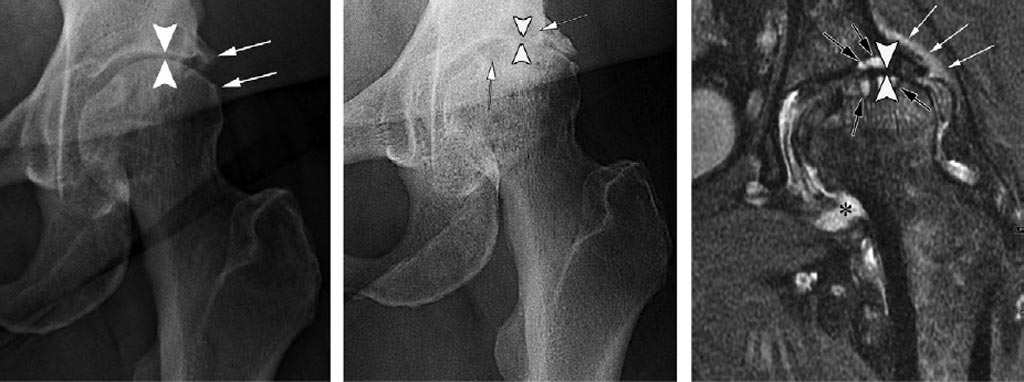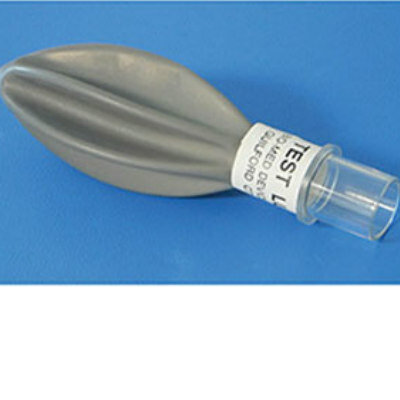Steroid Injections May Damage Hip and Knee Joints
|
By HospiMedica International staff writers Posted on 26 Oct 2019 |

Image: Progressive loss of acetabular and femoral cartilage and subchondral cystic changes after IACS (Photo courtesy of Ali Guermazi Radiology).
A new study suggests that intra-articular corticosteroid (IACS) injections could lead to accelerated joint destruction, and may hasten the need for total hip and knee replacements.
Researchers at Boston University School of Medicine (BUSM; MA, USA), the French National Institute of Sports (INSEP; Paris, France), and Friedrich-Alexander University Erlangen-Nürnberg (FAU; Germany) undertook a review of the existing literature in order to describe observed adverse joint events following the administration of IACS injections to treat osteoarthritis (OA) pain, and also to provide an outlook on how this may affect clinical practice.
The researchers identified four main adverse outcomes: accelerated osteoarthritis progression with loss of the joint space, osteonecrosis complications, subchondral insufficiency fractures (stress fractures beneath the cartilage), and rapid joint destruction, including bone loss. They thus recommend careful scrutiny of patients with mild or no OA on X-rays who are referred for IASC, especially when the pain reported is disproportionate to imaging findings, and that patients need to be told of the potential consequences of a corticosteroid injection before they receive it. The study was published on October 15, 2019, in Radiology.
“Intra-articular joint injection of steroids is a very common treatment for osteoarthritis-related pain, but potential aggravation of pre-existing conditions or actual side effects in a subset of patients need to be explored further to better understand the risks associated,” said lead author Professor Ali Guermazi, MD, PhD, of BUMC. “We've been telling patients that even if these injections don't relieve your pain, they're not going to hurt you. But now we suspect that this is not necessarily the case.”
OA is a group of mechanical abnormalities involving degradation of joints, including articular cartilage and subchondral bone. Symptoms may include joint pain, tenderness, stiffness, locking, and sometimes an effusion. A variety of causes--hereditary, developmental, metabolic, and mechanical deficits--may initiate processes leading to loss of cartilage. As a result of decreased movement secondary to pain, regional muscles may atrophy, and ligaments may become more lax. OA of the knee affects about 250 million people worldwide (3.6% of the population).
Related Links:
Boston University School of Medicine
French National Institute of Sports
Friedrich-Alexander University Erlangen-Nürnberg
Researchers at Boston University School of Medicine (BUSM; MA, USA), the French National Institute of Sports (INSEP; Paris, France), and Friedrich-Alexander University Erlangen-Nürnberg (FAU; Germany) undertook a review of the existing literature in order to describe observed adverse joint events following the administration of IACS injections to treat osteoarthritis (OA) pain, and also to provide an outlook on how this may affect clinical practice.
The researchers identified four main adverse outcomes: accelerated osteoarthritis progression with loss of the joint space, osteonecrosis complications, subchondral insufficiency fractures (stress fractures beneath the cartilage), and rapid joint destruction, including bone loss. They thus recommend careful scrutiny of patients with mild or no OA on X-rays who are referred for IASC, especially when the pain reported is disproportionate to imaging findings, and that patients need to be told of the potential consequences of a corticosteroid injection before they receive it. The study was published on October 15, 2019, in Radiology.
“Intra-articular joint injection of steroids is a very common treatment for osteoarthritis-related pain, but potential aggravation of pre-existing conditions or actual side effects in a subset of patients need to be explored further to better understand the risks associated,” said lead author Professor Ali Guermazi, MD, PhD, of BUMC. “We've been telling patients that even if these injections don't relieve your pain, they're not going to hurt you. But now we suspect that this is not necessarily the case.”
OA is a group of mechanical abnormalities involving degradation of joints, including articular cartilage and subchondral bone. Symptoms may include joint pain, tenderness, stiffness, locking, and sometimes an effusion. A variety of causes--hereditary, developmental, metabolic, and mechanical deficits--may initiate processes leading to loss of cartilage. As a result of decreased movement secondary to pain, regional muscles may atrophy, and ligaments may become more lax. OA of the knee affects about 250 million people worldwide (3.6% of the population).
Related Links:
Boston University School of Medicine
French National Institute of Sports
Friedrich-Alexander University Erlangen-Nürnberg
Latest Surgical Techniques News
- Robotic Assistant Delivers Ultra-Precision Injections with Rapid Setup Times
- Minimally Invasive Endoscopic Surgery Improves Severe Stroke Outcomes
- Novel Glue Prevents Complications After Breast Cancer Surgery
- Breakthrough Brain Implant Enables Safer and More Precise Drug Delivery
- Bioadhesive Sponge Stops Uncontrolled Internal Bleeding During Surgery
- Revolutionary Nano Bone Material to Accelerate Surgery and Healing
- Superior Orthopedic Implants Combat Infections and Quicken Healing After Surgery
- Laser-Based Technique Eliminates Pancreatic Tumors While Protecting Healthy Tissue
- Surgical Treatment of Severe Carotid Artery Stenosis Benefits Blood-Brain Barrier
- Revolutionary Reusable Duodenoscope Introduces 68-Minute Sterilization
- World's First Transcatheter Smart Implant Monitors and Treats Congestion in Heart Failure
- Hybrid Endoscope Marks Breakthrough in Surgical Visualization
- Robot-Assisted Bronchoscope Diagnoses Tiniest and Hardest to Reach Lung Tumors
- Diamond-Titanium Device Paves Way for Smart Implants that Warn of Disease Progression
- 3D Printable Bio-Active Glass Could Serve as Bone Replacement Material
- Spider-Inspired Magnetic Soft Robots to Perform Minimally Invasive GI Tract Procedures
Channels
Critical Care
view channel
CPR Guidelines Updated for Pediatric and Neonatal Emergency Care and Resuscitation
Cardiac arrest in infants and children remains a leading cause of pediatric emergencies, with more than 7,000 out-of-hospital and 20,000 in-hospital cardiac arrests occurring annually in the United States.... Read more
Ingestible Capsule Monitors Intestinal Inflammation
Acute mesenteric ischemia—a life-threatening condition caused by blocked blood flow to the intestines—remains difficult to diagnose early because its symptoms often mimic common digestive problems.... Read more
Wireless Implantable Sensor Enables Continuous Endoleak Monitoring
Endovascular aneurysm repair (EVAR) is a life-saving, minimally invasive treatment for abdominal aortic aneurysms—balloon-like bulges in the aorta that can rupture with fatal consequences.... Read more
Wearable Patch for Early Skin Cancer Detection to Reduce Unnecessary Biopsies
Skin cancer remains one of the most dangerous and common cancers worldwide, with early detection crucial for improving survival rates. Traditional diagnostic methods—visual inspections, imaging, and biopsies—can... Read morePatient Care
view channel
Revolutionary Automatic IV-Line Flushing Device to Enhance Infusion Care
More than 80% of in-hospital patients receive intravenous (IV) therapy. Every dose of IV medicine delivered in a small volume (<250 mL) infusion bag should be followed by subsequent flushing to ensure... Read more
VR Training Tool Combats Contamination of Portable Medical Equipment
Healthcare-associated infections (HAIs) impact one in every 31 patients, cause nearly 100,000 deaths each year, and cost USD 28.4 billion in direct medical expenses. Notably, up to 75% of these infections... Read more
Portable Biosensor Platform to Reduce Hospital-Acquired Infections
Approximately 4 million patients in the European Union acquire healthcare-associated infections (HAIs) or nosocomial infections each year, with around 37,000 deaths directly resulting from these infections,... Read moreFirst-Of-Its-Kind Portable Germicidal Light Technology Disinfects High-Touch Clinical Surfaces in Seconds
Reducing healthcare-acquired infections (HAIs) remains a pressing issue within global healthcare systems. In the United States alone, 1.7 million patients contract HAIs annually, leading to approximately... Read moreHealth IT
view channel
Printable Molecule-Selective Nanoparticles Enable Mass Production of Wearable Biosensors
The future of medicine is likely to focus on the personalization of healthcare—understanding exactly what an individual requires and delivering the appropriate combination of nutrients, metabolites, and... Read moreBusiness
view channel
Philips and Masimo Partner to Advance Patient Monitoring Measurement Technologies
Royal Philips (Amsterdam, Netherlands) and Masimo (Irvine, California, USA) have renewed their multi-year strategic collaboration, combining Philips’ expertise in patient monitoring with Masimo’s noninvasive... Read more
B. Braun Acquires Digital Microsurgery Company True Digital Surgery
The high-end microsurgery market in neurosurgery, spine, and ENT is undergoing a significant transformation. Traditional analog microscopes are giving way to digital exoscopes, which provide improved visualization,... Read more
CMEF 2025 to Promote Holistic and High-Quality Development of Medical and Health Industry
The 92nd China International Medical Equipment Fair (CMEF 2025) Autumn Exhibition is scheduled to be held from September 26 to 29 at the China Import and Export Fair Complex (Canton Fair Complex) in Guangzhou.... Read more












